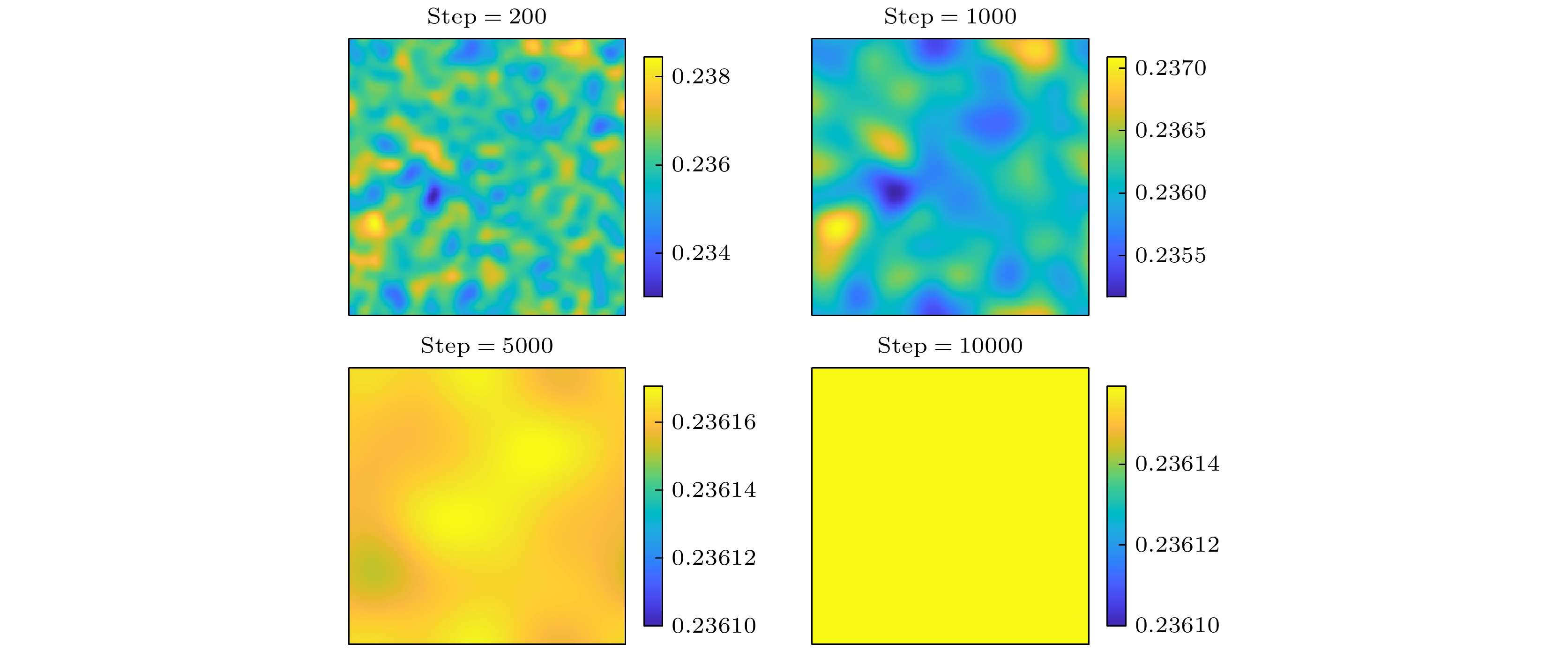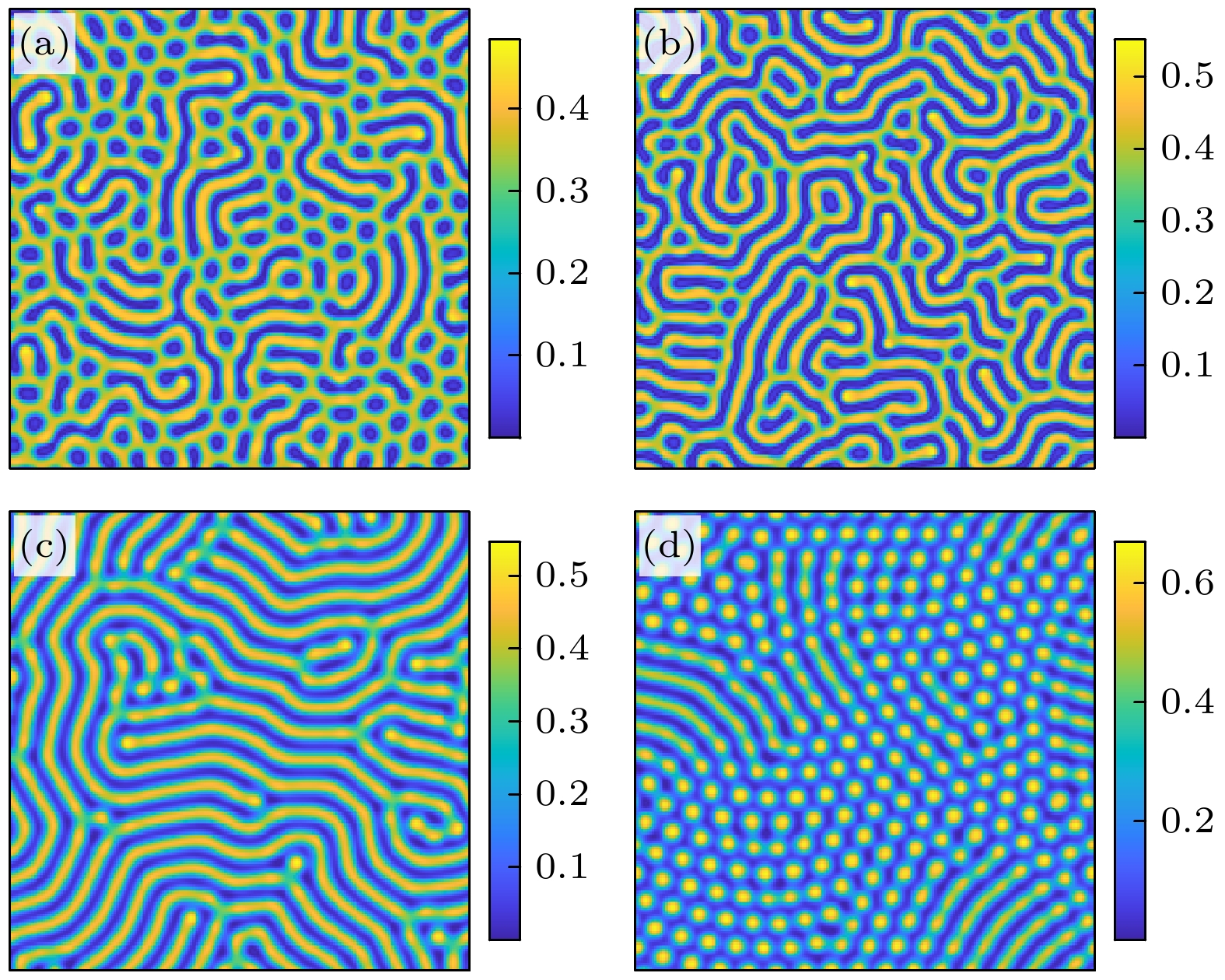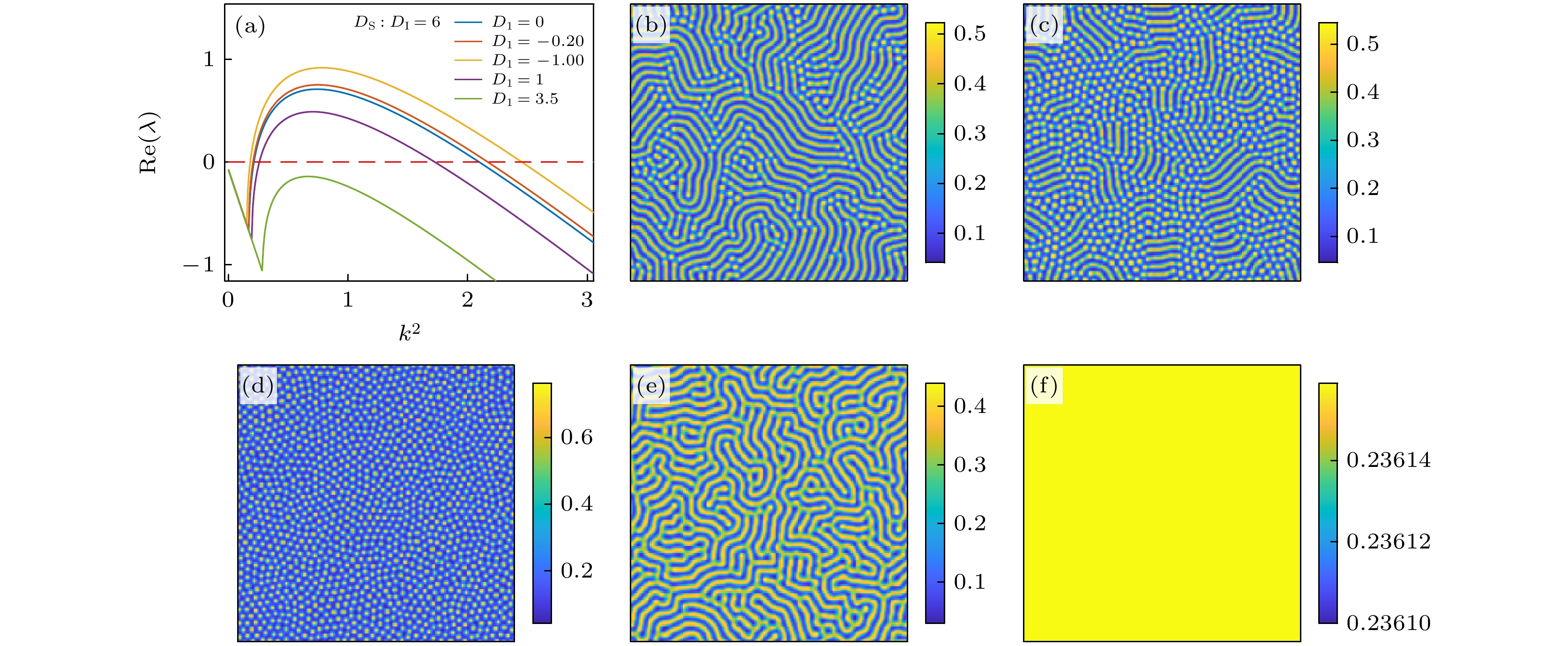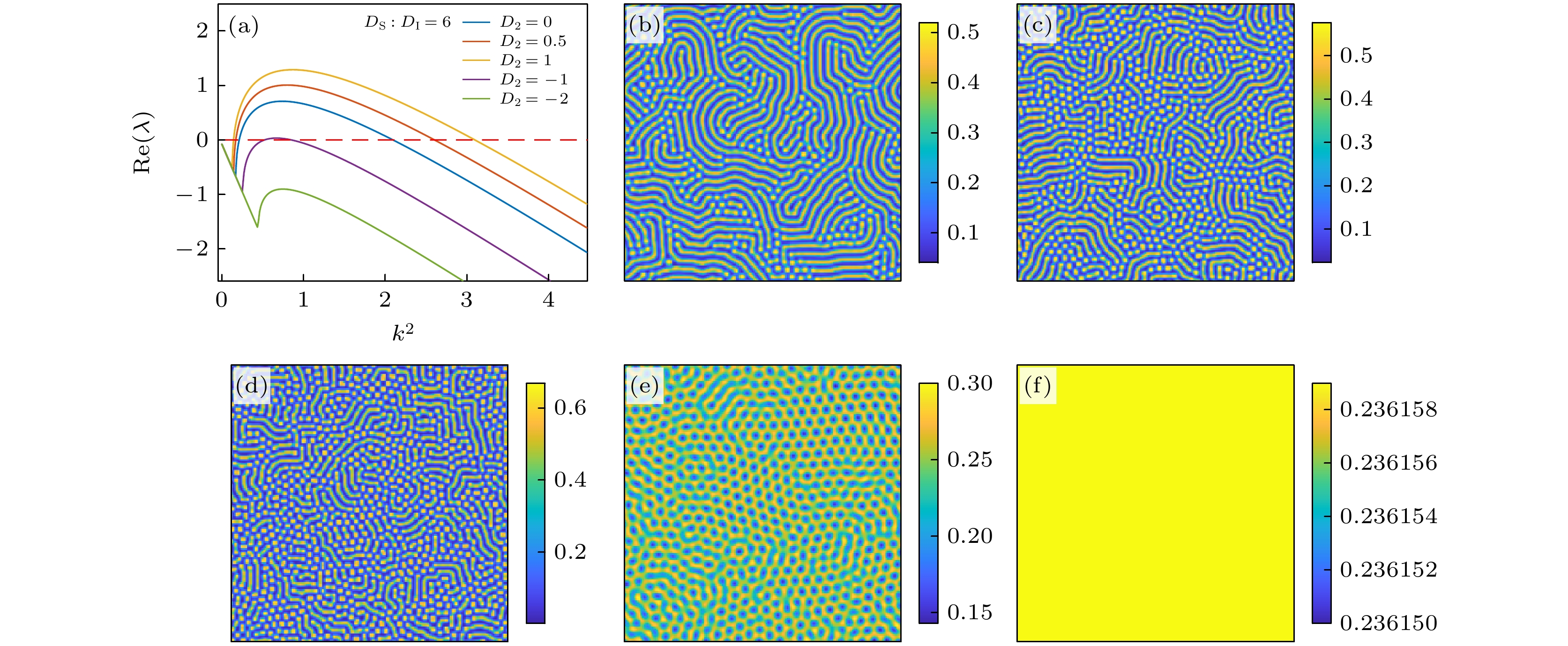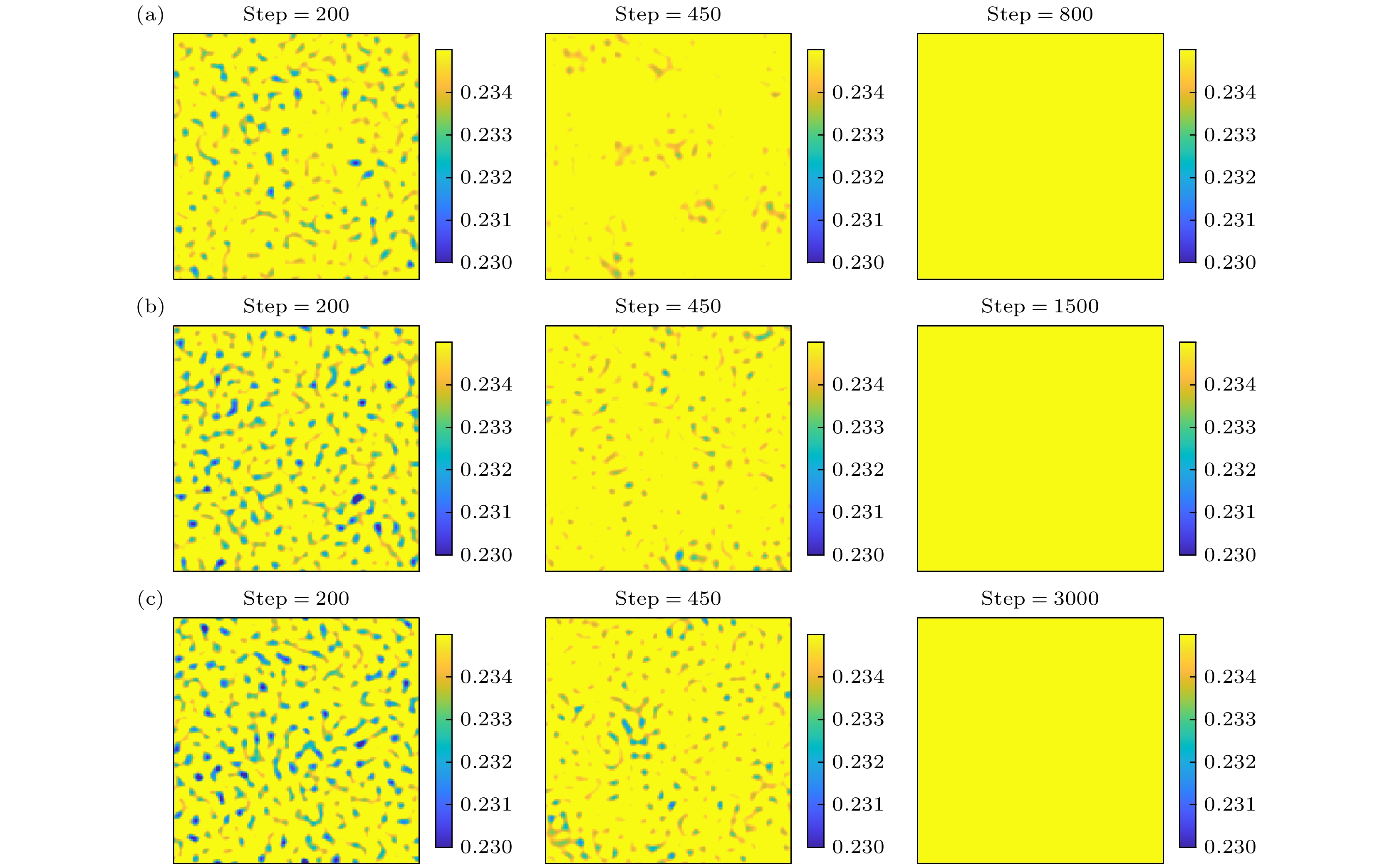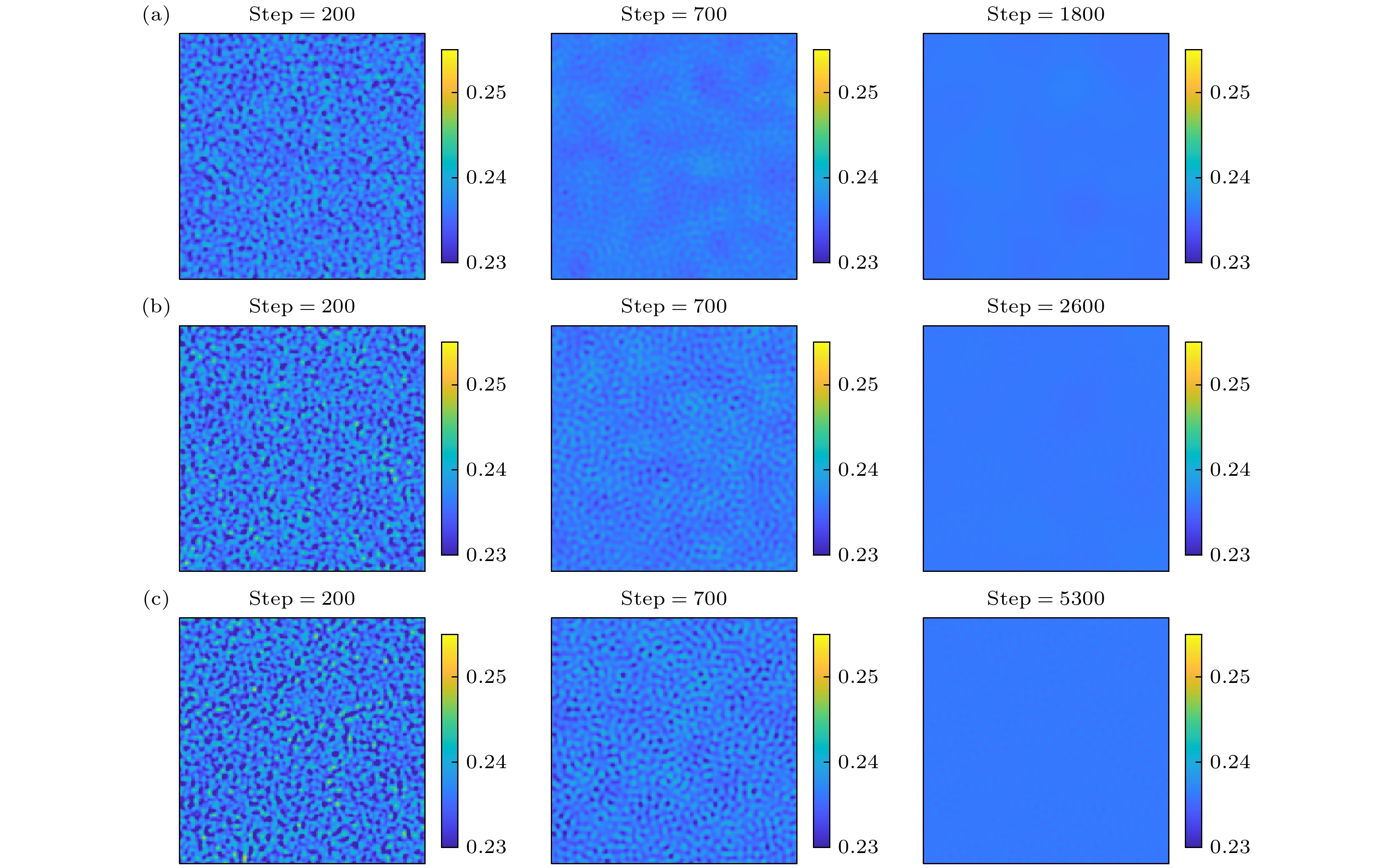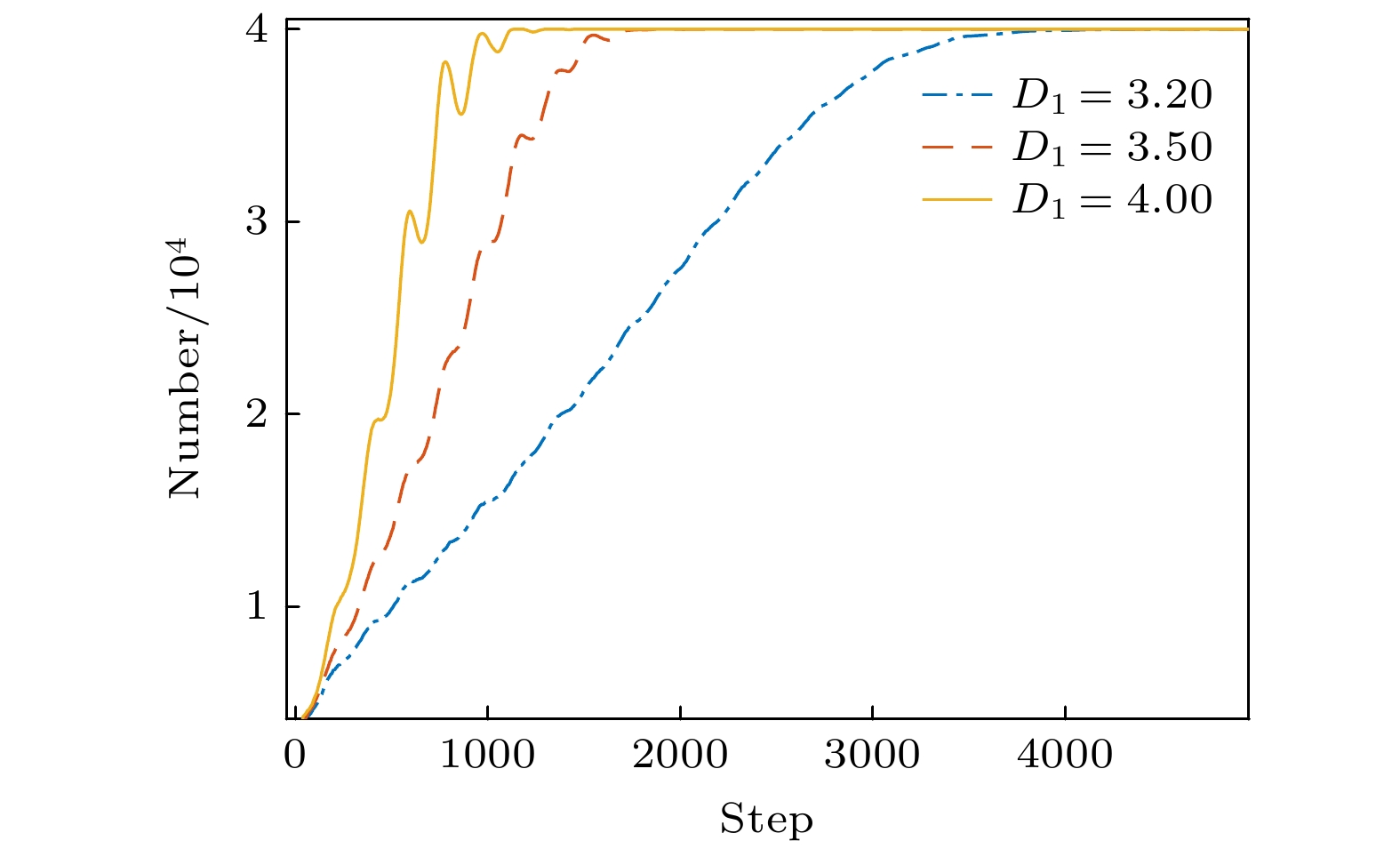-
Currently, most of researches on the spatial patterns of the SI model focus on the influences of self-diffusion and system parameters on pattern formation, but only a few studies involve how cross-diffusion influences the evolution of spatial patterns. In this paper, we establish a spatial epidemic model that considers both self-diffusion and cross-diffusion and investigate the effects of cross-diffusion on the stability, the rate of stability, and the pattern structure of the SI model with or without self-diffusion-driven system instability. The stability of the non-diffusive system is analyzed, and the conditions for Turing instability in the presence of diffusion terms are elucidated. It is found that when the system is stable under self-diffusion-driven conditions, the introduction of cross-diffusion can change the system's local stability, and produce Turing patterns as well. Furthermore, different cross-diffusion coefficients can generate patterns with different structures. When the system is unstable under self-diffusion-driven conditions, the introduction of cross-diffusion can change the pattern structure. Specifically, when the cross-diffusion coefficient
$D_1$ for the susceptible individuals is negative, the pattern structure is transformed from spot-stripe patterns into spot patterns, and when it is positive, the pattern structureturns from spot-stripe patterns into labyrinthine patterns, and eventually into a uniform solid color distribution. When the cross-diffusion coefficient$D_2$ for the infected individuals is positive, the pattern transformation is similar to when the cross-diffusion coefficient$D_1$ for susceptible individuals is negative, the pattern graduallychanges into spot patterns. When$D_2$ is negative, the pattern structure exhibits a porous structure, eventually it is transformed into a uniform solid color distribution. Regarding the rate of stability of the SI model, in the case of a stable self-diffusion system, the introduction of cross-diffusion may change the rate of system stability, and the larger the cross-diffusion coefficient$D_1$ for the susceptible individuals, the faster the system stabilizes. When the self-diffusion-driven system is unstable, the cross-diffusion causes the system to change from an unstable state into a locally stable state, and the smaller the susceptible individuals' cross-diffusion coefficient, the slower the rate of system stabilization is. Therefore, cross-diffusion has a significantinfluence on the stability, the rate of stability, and the pattern structure of the SI model.-
Keywords:
- Turing instability /
- nonlinear incidence rate /
- cross diffusion /
- Turing pattern
[1] Turing A M 1952 Philos. Trans. R. Soc. London, Ser. B 2 37
 Google Scholar
Google Scholar
[2] Capone F, Carfora M F, De Luca R, Torcicollo I 2019 Math. Comput. Simul. 165 172
 Google Scholar
Google Scholar
[3] Ali I, Saleem M T 2023 Mathematics 11 1459
 Google Scholar
Google Scholar
[4] Hu J, Zhu L, Peng M 2022 Inf. Sci. 596 501
 Google Scholar
Google Scholar
[5] Ruiz-Baier R, Tian C 2013 Nonlinear Anal. Real World Appl. 14 601
 Google Scholar
Google Scholar
[6] Sun G Q, Jin Z, Liu Q X, Li L 2007 J. Stat. Mech. Theory Exp. 2007 P11011
 Google Scholar
Google Scholar
[7] 刘若琪, 贾萌萌, 范伟丽, 贺亚峰, 刘富成 2022 物理学报 71 248201
 Google Scholar
Google Scholar
Liu R Q, Jia M M, Fan W L, He Y F, Liu F C 2022 Acta Phys. Sin. 71 248201
 Google Scholar
Google Scholar
[8] 张荣培, 王震, 王语, 韩子健 2018 物理学报 67 050503
 Google Scholar
Google Scholar
Zhang R P, Wang Z, Wang Y, Han Z J 2018 Acta Phys. Sin. 67 050503
 Google Scholar
Google Scholar
[9] Giri A, Pramod Jain S, Kar S 2020 Chemphyschem 21 1608
 Google Scholar
Google Scholar
[10] 王楠, 肖敏, 蒋海军, 黄霞 2022 物理学报 71 180201
 Google Scholar
Google Scholar
Wang N, Xiao M, Jiang H J, Huang X 2022 Acta Phys. Sin. 71 180201
 Google Scholar
Google Scholar
[11] 王凌志, 周先春, 陈铭 2019 信息与控制 48 559
 Google Scholar
Google Scholar
Wang L Z, Zhou X C, Chen M 2019 Inf. Control. 48 559
 Google Scholar
Google Scholar
[12] Pastor-Satorras R, Castellano C, Van Mieghem P, Vespignani A 2015 Rev. Mod. Phys. 87 925
 Google Scholar
Google Scholar
[13] Wang W, Cai Y, Wu M 2012 Nonlinear Anal. Real. World Appl. 13 2240
 Google Scholar
Google Scholar
[14] 阮中远 2020 中国科学: 物理学 力学 天文学 50 010507
 Google Scholar
Google Scholar
Ruan Z Y 2020 Sci. Sin-Phys. Mech. Astron. 50 010507
 Google Scholar
Google Scholar
[15] Wang L, Li X 2014 Chin. Sci. Bull. 59 3511
 Google Scholar
Google Scholar
[16] Sun G Q, Jusup M, Jin Z, Wang Y, Wang Z 2016 Phys. Life Rev. 19 43
 Google Scholar
Google Scholar
[17] Guin L N, Acharya S 2017 Nonlinear Dyn. 88 1501
 Google Scholar
Google Scholar
[18] Zhao L, Wang Z C, Ruan S 2020 Nonlinear Anal. Real World Appl. 51 102966
 Google Scholar
Google Scholar
[19] Zheng Q, Pandey V, Shen J, Xu Y, Guan L 2022 EPL 137 42002
 Google Scholar
Google Scholar
[20] Kuniya T, Wang J 2018 Nonlinear Anal. Real World Appl. 43 262
 Google Scholar
Google Scholar
[21] Ahmed N, Fatima M, Baleanu D, Nisar K S, Khan I, Rafiq M, Rehman M A U, Ahmad M O 2020 Front. Phys. 7 220
 Google Scholar
Google Scholar
[22] Wang W, Gao X, Cai Y, Shi H, Fu S 2018 J. Franklin Inst. 355 7226
 Google Scholar
Google Scholar
[23] Sun G Q 2012 Nonlinear Dyn. 69 1097
 Google Scholar
Google Scholar
[24] Kerner E H 1957 Bull. Math. Biol. 19 121
 Google Scholar
Google Scholar
[25] Fan Y 2014 Appl. Math. Comput. 228 311
 Google Scholar
Google Scholar
[26] Ghorai S, Poria S 2016 Chaos Solitons Fractals 91 421
 Google Scholar
Google Scholar
[27] Aly S, Khenous H B, Hussien F 2015 Int. J. Biomath. 8 1550006
 Google Scholar
Google Scholar
[28] Triska A, Gunawan A Y, Nuraini N 2022 J. Math. Computer Sci. 27 1
 Google Scholar
Google Scholar
[29] Brauer F, Driessche P V D 2001 Math. Biosci. 171 143
 Google Scholar
Google Scholar
[30] Chinviriyasit S, Chinviriyasit W 2010 Appl. Math. Comput. 216 395
 Google Scholar
Google Scholar
[31] Simon C P, Jacquez J A 1992 SIAM J. Appl. Math. 52 541
 Google Scholar
Google Scholar
[32] Hethcote H W, van den Driessche P 1991 J. Math. Biol. 29 271
 Google Scholar
Google Scholar
-
图 4 不同取值的交叉扩散系数$D_1$的色散关系曲线及空间格局 (a)色散关系曲线; (b)$D_1$= 0; (c)$D_1=-0.2$; (d) $D_1=-1$; (e)$D_1=1$; (f)$D_1=3.5$
Figure 4. Dispersion relationship curves and spatial patterns of cross diffusion coefficients $D_1$ with different values: (a) Dispersion relationship curve; (b)$D_1=0$; (c)$D_1=-0.2$; (d)$D_1=-1$; (e)$D_1=1$; (f)$D_1=3.5$
图 5 不同取值的交叉扩散系数$D_2$的色散关系曲线及空间格局 (a)色散关系曲线; (b)$D_2=0$; (c)$D_2=0.5$; (d)$D_2=1$;(e)$D_2=-1$; (f)$D_2=-2$
Figure 5. Dispersion relationship curves and spatial patterns of cross diffusion coefficients $D_2$ with different values: (a) Dispersion relationship curve; (b)$D_2=0$; (c)$D_2=0.5$; (d)$D_2=1$; (e)$D_1=-1$; (f)$D_1=-2$
-
[1] Turing A M 1952 Philos. Trans. R. Soc. London, Ser. B 2 37
 Google Scholar
Google Scholar
[2] Capone F, Carfora M F, De Luca R, Torcicollo I 2019 Math. Comput. Simul. 165 172
 Google Scholar
Google Scholar
[3] Ali I, Saleem M T 2023 Mathematics 11 1459
 Google Scholar
Google Scholar
[4] Hu J, Zhu L, Peng M 2022 Inf. Sci. 596 501
 Google Scholar
Google Scholar
[5] Ruiz-Baier R, Tian C 2013 Nonlinear Anal. Real World Appl. 14 601
 Google Scholar
Google Scholar
[6] Sun G Q, Jin Z, Liu Q X, Li L 2007 J. Stat. Mech. Theory Exp. 2007 P11011
 Google Scholar
Google Scholar
[7] 刘若琪, 贾萌萌, 范伟丽, 贺亚峰, 刘富成 2022 物理学报 71 248201
 Google Scholar
Google Scholar
Liu R Q, Jia M M, Fan W L, He Y F, Liu F C 2022 Acta Phys. Sin. 71 248201
 Google Scholar
Google Scholar
[8] 张荣培, 王震, 王语, 韩子健 2018 物理学报 67 050503
 Google Scholar
Google Scholar
Zhang R P, Wang Z, Wang Y, Han Z J 2018 Acta Phys. Sin. 67 050503
 Google Scholar
Google Scholar
[9] Giri A, Pramod Jain S, Kar S 2020 Chemphyschem 21 1608
 Google Scholar
Google Scholar
[10] 王楠, 肖敏, 蒋海军, 黄霞 2022 物理学报 71 180201
 Google Scholar
Google Scholar
Wang N, Xiao M, Jiang H J, Huang X 2022 Acta Phys. Sin. 71 180201
 Google Scholar
Google Scholar
[11] 王凌志, 周先春, 陈铭 2019 信息与控制 48 559
 Google Scholar
Google Scholar
Wang L Z, Zhou X C, Chen M 2019 Inf. Control. 48 559
 Google Scholar
Google Scholar
[12] Pastor-Satorras R, Castellano C, Van Mieghem P, Vespignani A 2015 Rev. Mod. Phys. 87 925
 Google Scholar
Google Scholar
[13] Wang W, Cai Y, Wu M 2012 Nonlinear Anal. Real. World Appl. 13 2240
 Google Scholar
Google Scholar
[14] 阮中远 2020 中国科学: 物理学 力学 天文学 50 010507
 Google Scholar
Google Scholar
Ruan Z Y 2020 Sci. Sin-Phys. Mech. Astron. 50 010507
 Google Scholar
Google Scholar
[15] Wang L, Li X 2014 Chin. Sci. Bull. 59 3511
 Google Scholar
Google Scholar
[16] Sun G Q, Jusup M, Jin Z, Wang Y, Wang Z 2016 Phys. Life Rev. 19 43
 Google Scholar
Google Scholar
[17] Guin L N, Acharya S 2017 Nonlinear Dyn. 88 1501
 Google Scholar
Google Scholar
[18] Zhao L, Wang Z C, Ruan S 2020 Nonlinear Anal. Real World Appl. 51 102966
 Google Scholar
Google Scholar
[19] Zheng Q, Pandey V, Shen J, Xu Y, Guan L 2022 EPL 137 42002
 Google Scholar
Google Scholar
[20] Kuniya T, Wang J 2018 Nonlinear Anal. Real World Appl. 43 262
 Google Scholar
Google Scholar
[21] Ahmed N, Fatima M, Baleanu D, Nisar K S, Khan I, Rafiq M, Rehman M A U, Ahmad M O 2020 Front. Phys. 7 220
 Google Scholar
Google Scholar
[22] Wang W, Gao X, Cai Y, Shi H, Fu S 2018 J. Franklin Inst. 355 7226
 Google Scholar
Google Scholar
[23] Sun G Q 2012 Nonlinear Dyn. 69 1097
 Google Scholar
Google Scholar
[24] Kerner E H 1957 Bull. Math. Biol. 19 121
 Google Scholar
Google Scholar
[25] Fan Y 2014 Appl. Math. Comput. 228 311
 Google Scholar
Google Scholar
[26] Ghorai S, Poria S 2016 Chaos Solitons Fractals 91 421
 Google Scholar
Google Scholar
[27] Aly S, Khenous H B, Hussien F 2015 Int. J. Biomath. 8 1550006
 Google Scholar
Google Scholar
[28] Triska A, Gunawan A Y, Nuraini N 2022 J. Math. Computer Sci. 27 1
 Google Scholar
Google Scholar
[29] Brauer F, Driessche P V D 2001 Math. Biosci. 171 143
 Google Scholar
Google Scholar
[30] Chinviriyasit S, Chinviriyasit W 2010 Appl. Math. Comput. 216 395
 Google Scholar
Google Scholar
[31] Simon C P, Jacquez J A 1992 SIAM J. Appl. Math. 52 541
 Google Scholar
Google Scholar
[32] Hethcote H W, van den Driessche P 1991 J. Math. Biol. 29 271
 Google Scholar
Google Scholar
Catalog
Metrics
- Abstract views: 5056
- PDF Downloads: 82
- Cited By: 0
















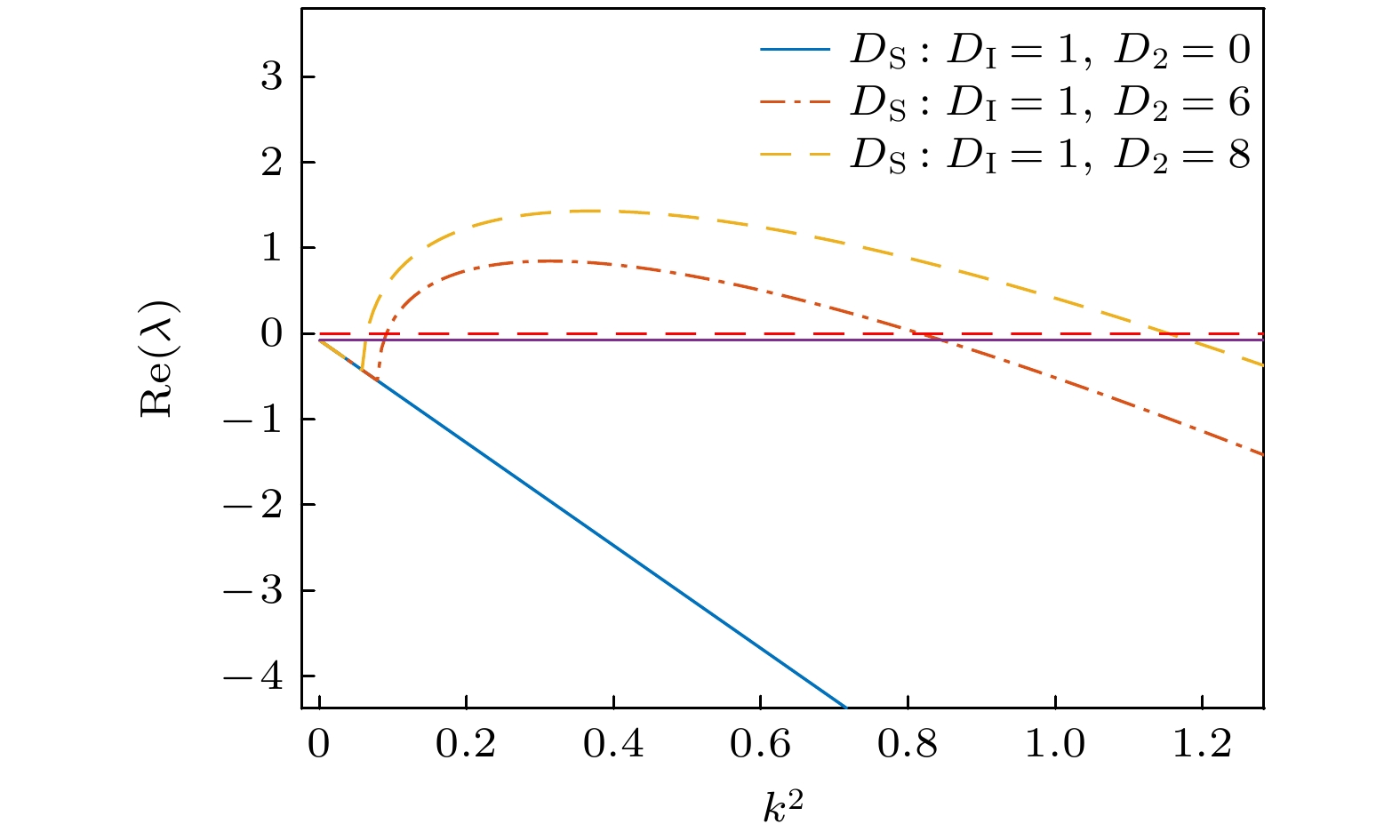
 DownLoad:
DownLoad:
